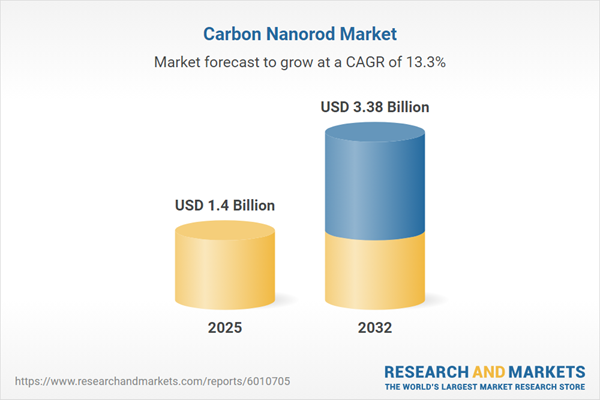Speak directly to the analyst to clarify any post sales queries you may have.
As businesses navigate rapid changes in advanced materials, the carbon nanorod market is emerging as a catalyst for operational advancement and competitive response. Senior decision-makers are increasingly evaluating carbon nanorods for their strategic importance in regulatory alignment, productivity, and resilient technology adoption.
Market Snapshot: Carbon Nanorod Market Size and Growth
The carbon nanorod market is in a phase of sizable expansion, currently valued at USD 1.24 billion in 2024 and anticipated to reach USD 1.40 billion by 2025. Forward-looking analysis shows potential growth to USD 3.38 billion by 2032, supported by a compound annual growth rate (CAGR) of 13.31%. Primary drivers include higher adoption in advanced manufacturing and electronics, spurred by rising demand for efficient, specialty materials. Recent innovations continue to broaden application in energy systems, while tailored nanorod integration is gaining traction as organizations seek new composite materials and technology solutions. This momentum is particularly strong in sectors investing in refined composites and components for next-generation systems.
Scope & Segmentation of the Carbon Nanorod Market
- Applications: Utilized across bioimaging, tissue engineering, drug delivery, chemical processing, photocatalysis, anti-corrosion, engineered composites, conductive films, data storage, fuel cells, supercapacitors, semiconductor interconnects, biosensors, chemical sensors, and gas detection systems—directly addressing critical needs in life sciences, electronics, and manufacturing workflows.
- Synthesis Methods: Chemical vapor deposition, electrospinning, hydrothermal, and solvothermal approaches provide precise customization for performance optimization in diverse industry sectors.
- Product Types: Includes functionalized nanorods, hollow structures, and solid core designs, each serving different needs in laboratory research, high-tech electronics, and broad industrial manufacturing.
- Particle Size Distribution: Offerings range from sub-50 nanometer particles to larger forms, supporting high-precision integration and scalable production for varied applications.
- Regions Covered: Comprehensive coverage includes North America, Brazil-driven South America, the UK, Germany, France, the Middle East with a Saudi Arabia focus, South Africa, and a robust Asia-Pacific landscape featuring China, India, Japan, Australia, and Southeast Asia—each evaluated for technology uptake and supply dynamics.
- Key Companies Analyzed: Profiles feature Cabot Corporation, Denka Company Limited, Showa Denko K.K., Tokai Carbon Co., Ltd., Orion Engineered Carbons, Arkema S.A., NanoXplore Inc., Nanografi Nanotechnology, NanoAmor, Inc., and FutureCarbon GmbH, analyzed according to their roles in innovation, commercialization, and the advanced materials value chain.
Key Takeaways for Senior Decision-Makers
- Applying carbon nanorod-based solutions in product development helps organizations tap into emerging technologies, notably in next-generation energy and catalytic systems.
- Innovative synthesis approaches open doors to new use-cases, facilitating progress across medical devices, smart electronics, and robust structural designs.
- Expanding nanorod offerings enables companies to remain agile in adapting to policy and industry standard changes, supporting stronger compliance and customer satisfaction.
- Developing multi-regional supply strategies improves responsiveness and access to critical materials during shifting supply chain or regulatory conditions.
- Investment patterns and regulatory shifts—especially in Asia-Pacific and North America—are directing innovation and research priorities, shaping the competitive landscape for advanced materials players.
Tariff Impact: Navigating Supply Chain Adaptation
Recent adjustments in U.S. tariff policy are reshaping supply chain planning for carbon nanorods. Domestic producers are increasing output, while global suppliers modify logistics and delivery to remain responsive. These efforts assist companies in containing costs, supporting consistent material supply, and safeguarding reliable market access as regulations evolve.
Methodology & Data Sources
This report is grounded in direct interviews with industry leaders, in-depth analysis of scientific literature and regulatory records, recent patent trends, and feedback from market participants. These methodologies underpin the report’s rigor and provide relevant intelligence for strategy formulation.
Why the Carbon Nanorod Market Report Matters
- Informs executive decision-making by offering benchmarks on technology adoption and competitive investment within leading markets and top organizations.
- Delivers actionable insights for regulatory planning and agile response to fast-changing policy environments in advanced materials sectors.
- Supports strategic assessments of investment and partnership opportunities to advance innovation in high-performance material solutions.
Conclusion
Prioritizing scalable, cross-sector adoption of carbon nanorod solutions empowers leaders to harness future advancements and reinforce organizational adaptability in the evolving materials economy.
Additional Product Information:
- Purchase of this report includes 1 year online access with quarterly updates.
- This report can be updated on request. Please contact our Customer Experience team using the Ask a Question widget on our website.
Table of Contents
3. Executive Summary
4. Market Overview
7. Cumulative Impact of Artificial Intelligence 2025
Companies Mentioned
The companies profiled in this Carbon Nanorod market report include:- Cabot Corporation
- Denka Company Limited
- Showa Denko K.K.
- Tokai Carbon Co., Ltd.
- Orion Engineered Carbons
- Arkema S.A.
- NanoXplore Inc.
- Nanografi Nanotechnology
- NanoAmor, Inc.
- FutureCarbon GmbH
Table Information
| Report Attribute | Details |
|---|---|
| No. of Pages | 193 |
| Published | November 2025 |
| Forecast Period | 2025 - 2032 |
| Estimated Market Value ( USD | $ 1.4 Billion |
| Forecasted Market Value ( USD | $ 3.38 Billion |
| Compound Annual Growth Rate | 13.3% |
| Regions Covered | Global |
| No. of Companies Mentioned | 11 |









